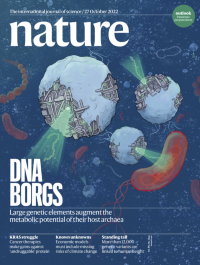Volume 610
-
No. 7933 27 October 2022
DNA BorgsThe cover shows an artist’s interpretation of Borgs, a novel kind of extrachromosomal element described by Jillian Banfield and her colleagues in this week’s issue. Many microorganisms have extra genetic information encoded in DNA that is outside their chromosome. These extrachromosomal elements are usually in the form of relatively small plasmids. But in their analysis of groundwater, sediments and wetland soil, Banfield and her colleagues found that species of the methane-oxidizing archaea Methanoperedens hosted unusually large, linear extrachromosomal elements. The team named these elements Borgs — after the aliens in Star Trek — because they assimilate genetic material from other organisms and their environment. The researchers identified at least 19 types of Borg and speculate that they might be helping their hosts to consume methane.
Nature Outlook
-
No. 7932 20 October 2022
RacismRacism casts a huge shadow on science. People of colour and from other historically marginalized groups have been excluded from the scientific enterprise, research has been used to underpin discriminatory thinking, and research outputs have ignored and further disadvantaged marginalized people. Nature has played its part in creating this divisive legacy. In this special issue – the first in the journal’s 153-year history to be overseen by guest editors — Melissa Nobles, Chad Womack, Ambroise Wonkam and Elizabeth Wathuti present articles that examine some of the ways racism has manifested in science, and the direct and detrimental effects this toxic ideology has had on individuals and their communities. By highlighting these issues, Nature aims to help build a more inclusive future for science, and society, in which people of all colours can thrive.
-
No. 7931 13 October 2022
Turtle eclipsedDifferent terrains can present significant mobility challenges for robots — especially if the robot is required to move between environments. In this week’s issue, Rebecca Kramer-Bottiglio and her colleagues present a multi-environment robot that can readily navigate between land and water. The researchers took inspiration from the living world, designing their robot to morph between a tortoise-like configuration for terrestrial terrain and a turtle-like configuration for aquatic environments. The ‘adaptive morphogenesis’ design strategy allows the Amphibious Robotic Turtle to change its limb morphology and gait to cope with the different environments (as illustrated on the cover).
Nature Index
-
No. 7930 6 October 2022
Matrix gamesThe cover shows an artistic impression of a matrix multiplication tensor — a 3D array of numbers — in the process of being solved by deep learning. Efficient matrix multiplication algorithms can help speed up many computations, and in this week’s issue, Alhussein Fawzi and his colleagues at DeepMind show how machine learning can uncover faster algorithms. The system, called AlphaTensor, was trained on a game that involved finding the best way to ‘decompose’ a matrix multiplication tensor so as to find matrix multiplication algorithms. After training, AlphaTensor was able to rediscover previously known algorithms as well as to uncover new ones that, in some cases, improved on algorithms that have resisted improvement for more than 50 years.
Focal Point




